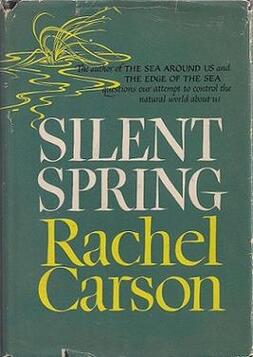The causes and effects of human induced environmental changes are complex and interrelated with consequences that may not be obvious but are none the less important.
Despite being heavily criticised by the chemical industry at the time of its publication, Rachel Carson was posthumously awarded the Presidential Medal of Freedom by U.S. President Jimmy Carter and her book is now recognised as one of the 25 greatest science books of all time. Early pesticides, such as DDT, were long lived chemicals in the environment and although applied to control insects, they accumulated as they moved up the food chain so had significant effects on higher trophic level organisms, especially birds. In predatory birds, such as falcons, DDT was blamed for the thinning of egg shells leading to egg breakages and declining populations. Rachel Carson chose Silent Spring as the name for her chapter about pesticide impacts on birds, inspired by a poem with the lines "The sedge is wither'd from the lake, And no birds sing." by the English Romantic poet John Keats. She later accepted a suggestion to make it the title of the book. At one level Silent Spring tells us about the perils of ignoring environmental management. At another level it shows us the complex inter-relatedness of ecology, lessons still salient today. November, in much of New Zealand's remaining native forest, is a silent spring not because of human impacts through pesticide use but through the introduction of invasive mammals. Our field station includes recovering native forest on steep slopes with kanuka forest along ridge lines that were once pasture, and mature native forest in the deep stream valley. The dry kanuka forest has a simple structure but the mature forest is diverse with large puriri, spreading kohekohe, towering nikau and emerging tawa. The understory, although not dense because of browsing, has Macropiper, mahoe, pigeonwood and rangiora. Supplejack, bush lawyer and rare kiekie climb from the ground into the canopy. It is not magnificent forest but it is functional forest. It is forest that should provide wildlife resources throughout the year from kohekohe flowering in winter to kowhai flowering in spring and rewarewa flowering through early summer. The massive puriri should produce fruit and flowers in all months of the year.
Yet stopping to listen along our traplines in November results in the loudest noise being the panting of our Labrador cross who enjoys pointing out the trap stations. Occasionally a sole tui call may be heard but for bird calls the best chance is to hear the twittering of a fantail chasing insects the dog has disturbed. When rain is forecast the delightful trilling of the grey warbler is a pleasant addition. Very very occasionally a pied tit will be heard and fleetingly seen. Does this pattern of wildlife encounters say anything about the natural processes at play in these silent forests? The received wisdom is that invasive mammals predate wildlife, and there is no doubt they do. But why are the native birds that are present predominantly insectivores? How come the insectivorous birds escape predation from mammalian predators to be the most frequently encountered birds in the forest? Or do they? The invasive mammals now present in New Zealand's forests include pure carnivores such as cats and stoats, but the rodents are omnivores with mice being mostly a herbivore. Could it be that insectivorous birds face the same predation pressure as all wildlife, but the birds that are not predominantly insect feeders, birds like silvereye and bellbird and kereru wood pigeon face the added pressure of food competition from invasive mammals. Should we be viewing the invasive mammals that have silenced the spring as being interlopers that not only prey directly on native wildlife but also prey on the food that feeds native wildlife by stripping the forest of its fruit and nectar resources so those birds who depend on those resources face both competition and predation from invasive mammals. In contrast, the insectivorous birds principally face just the predation side of this deadly combination. Sure, omnivorous rodents eat insects as well, especially large bodied invertebrates like weta, but the insect biomass in New Zealand forests is massive and it reproduces quickly. In contrast, most fruit is produced once a year and in some cases, can take months to ripen. Flowers, with their rich source of nectar, may last only days. The web of linkages, relationships, processes and feedbacks between all the elements that make up the forest ecosystem is bewilderingly complex, multidimensional and in a constant state of flux. At one level this new silent spring shows us the need for environmental management through invasive mammal control. At another level it tells us about the complex inter-relatedness of ecology, lessons that will be salient always.
0 Comments
Your comment will be posted after it is approved.
Leave a Reply. |
What's in a Name?The familiar saying "A bird in the hand is worth two in the bush" warns about the risks that come with trying to achieve more by challenging the status quo. Categories
All
Archives
January 2022
|
|
Copyright © Synovus Technology 2018 - 2023
All Rights Reserved |



 RSS Feed
RSS Feed
